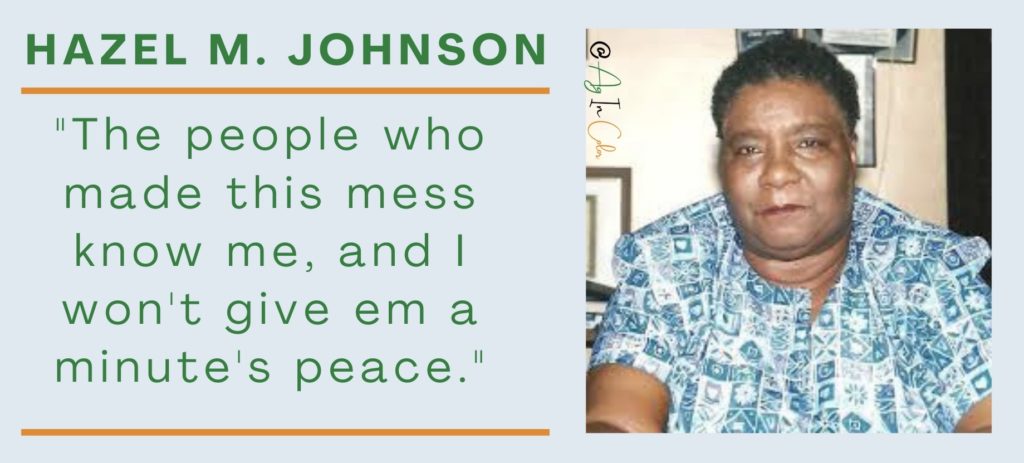“We have to fight for our children. We have educated ourselves on environmental issues and the health threats from nearby polluting industry. We have not waited for the government to come in and determine the cause of our illness. We may not have PhD degrees, but we are experts on our community.”
Hazel M. Johnson
First called the “Mother of Environmental Justice” at the 1992 First National People of Color Environmental Leadership Summit, Hazel M. Johnson was a mother, activist, and community researcher. Let’s get into it.
Hazel M. Johnson worked to improve the living conditions of her neighborhood in Southside Chicago. She learned from a news story that her neighborhood had the highest cancer rate of any area in the city. After some research, she found that her neighborhood, called Altgeld Gardens, was built on a landfill. Her neighborhood’s high cancer rates, foul odor, and respiratory illnesses were a result of environmental pollution. Altgeld Gardens was surrounded by toxicity and the residents paid the price.
“Why did they build homes here in the first place?”
As Black women do, Mrs. Johnson took matters into her own hands and founded the People for Community Recovery (PCR). PCR is a non-profit whose mission is to enhance the quality of life of residents affected by pollution. PCR worked to educate the residents of Altgeld Gardens on recognizing and testing for lead and lead poisoning, and encouraged the youth to be more involved in keeping their neighborhood clean. Mrs. Johnson led neighborhood health surveys to provide evidence that these marginalized, low-income residents were disproportionately impacted by environmental pollution.
Altgeld Gardens is located in the Calumet Industrial area, surrounded by a sewage center, abandoned industrial plants, and landfills. Initially pushed as the “Garden Spot of America,” Altgeld Gardens was built on a former toxic dump site and was described by Johnson as “a toxic doughnut.” (see photo below)

“It’s all very well to embrace saving the rain forests and conserving endangered animal species, BUT such global initiatives don’t even begin to impact communities inhabited by people of color.”
Not only did Mrs. Johnson work at the community level, she also worked at the national level. She collaborated with the US Environmental Protection Agency (EPA) and a team of activists to push then President Clinton to sign the Environmental Justice Executive Order, which directed the EPA and the federal government to identify at-risk communities and develop an environmental justice strategy.
Hazel M. Johnson’s dedication to a cleaner environment is undeniable. So much so, she was described as a “thorn in the side” of the Chicago waste industry. Sounds like good trouble to me.
Resources:
- Fighting the Good Fight [article]
- The Chicago Woman Who Fought to Clean Up the Southeast Side [article]
- Hazel M. Johnson, the Mother of Environmental Justice, was Catholic [article]
- Hazel M. Johnson, Mother of the Environmental Justice Movement [article]
- The Mother of Environmental Justice [article]
In Solidarity,

